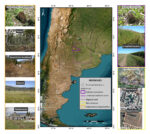Anthropogenic changes in land use and their consequences on rodent populations reservoirs of zoonotic viruses
María Daniela Gomez, María Andrea Previtali, José W. Priotto, María Cecilia ProvensalThe ecology of animal host species can be altered when their habitats are modified, affecting the transmission of their pathogens and the probability of disease risk in the human population. Predicting how zoonotic diseases emerge and spread in response to anthropogenic land use changes requires an understanding of how these changes influence hosts and pathogens. The objective of this paper is to analyze how urbanization, agricultural intensification, and invasive species have favored the increase in population abundance of host species and the transmission of zoonotic viruses. This work seeks to synthetize research conducted from the 1990s to the present day in different regions of Argentina on species of rodent reservoirs of the viruses that cause Argentine Hemorrhagic Fever, Lymphocytic Choriomeningitis and Hantavirus Pulmonary Syndrome. The data collected link the ecology of their host species, Calomys musculinus, Mus musculus, and Oligoryzomys longicaudatus, to anthropogenic processes in different types of environments (rural, urban, peri-urban, semi-natural, and natural).
Cambios antropogénicos en el uso de la tierra y sus consecuencias en poblaciones de roedores reservorios de virus zoonóticos. La ecología de especies animales hospedadoras puede alterarse cuando se modifican sus hábitats, y se afectan la transmisión de sus patógenos y la probabilidad de riesgo de enfermedad en la población humana. Predecir cómo surgen y se propagan las enfermedades zoonóticas en respuesta a los cambios antropogénicos del uso de la tierra requiere una comprensión de cómo estos cambios influyen en los hospedadores y patógenos. El objetivo del presente estudio es analizar cómo la urbanización, la intensificación agrícola y la introducción de especies exóticas han favorecido el aumento de la abundancia poblacional de especies hospedadoras y la transmisión de virus zoonóticos. Este estudio busca realizar una síntesis de las investigaciones desarrolladas desde la década de 1990 hasta la actualidad en diferentes regiones de Argentina sobre especies de roedores reservorios de los virus que producen fiebre hemorrágica argentina, coriomeningitis linfocitaria y síndrome pulmonar por hantavirus. Los datos relevados vinculan la ecología de sus especies hospedadoras Calomys musculinus, Mus musculus y Oligoryzomys longicaudatus, y su relación con los procesos antropogénicos en diferentes tipos de ambientes (rurales, urbanos, periurbanos, seminaturales y naturales).
